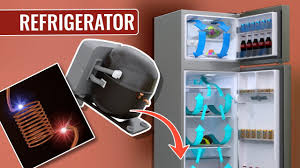Refrigerators are essential appliances in almost every household, keeping food fresh and safe. But have you ever wondered how they work? In this guide, we’ll explain how a fridge works step-by-step, explain how it gets cold, and even provide a simple explanation for kids. Let’s dive into the fantastic world of refrigerators!
How Does a Fridge Work Step by Step?
A fridge works by using the basic principle of removing heat from the inside of the fridge and releasing it outside. Here’s a step-by-step breakdown of how a refrigerator works:
- Cooling Starts with the Refrigerant: A fridge uses a special refrigerant fluid. This refrigerant can quickly change from a liquid to a gas and back to a liquid. Common refrigerants include substances like R-134a and R-600a.
- Compression: The refrigerant begins in the compressor, which is a motorized pump at the back of the fridge. The compressor squeezes the refrigerant into gas form, increasing its pressure and temperature. This is because compressing the gas makes its molecules pack together, making it hotter.
- Condensation: The hot, high-pressure refrigerant gas then flows through a set of coils on the back or bottom of the fridge called condenser coils. Here, the gas releases heat into the surrounding air and cools down, turning it into a liquid. This process is called condensation.
- Expansion: The now-liquid refrigerant is pushed through an expansion valve, reducing pressure. As the pressure drops, the refrigerant becomes cold and gas again.
- Evaporation in the Evaporator Coils: Next, the cold gas flows through the evaporator coils inside the fridge. Moving through these coils, it absorbs heat from the fridge’s interior. This heat absorption is what makes the inside of the fridge cold. The food inside the refrigerator releases heat, and the cold refrigerant absorbs it, keeping the temperature low.
- Cycle Repeats: After absorbing heat, the refrigerant turns into a warm gas and returns to the compressor, where the cycle begins again. This continuous cycle keeps the fridge cold all the time.
How Does a Fridge Get Cold?
A fridge gets cold through heat transfer. Essentially, it doesn’t produce cold; it removes heat. The refrigerant inside the fridge’s cooling system absorbs heat from the air and food inside. By continuously circulating the refrigerant through the coils, heat is removed from the fridge’s inside, making it more relaxed. The absorbed heat is then released outside the refrigerator, usually through coils at the back.
How Does a Fridge Work Simple for Kids?
Imagine a fridge is like a magic box that keeps things cold. Here’s a simple way to explain it to kids:
- Inside the fridge is a special liquid that loves to eat heat. When this liquid gets squeezed, it gets hot, like when you rub your hands together fast.
- The liquid then passes through a skinny pipe and cools down, just like water feels cold when it drips from a tap.
- After that, the liquid goes inside the fridge and becomes cold gas. It starts gobbling up all the heat, making everything inside the refrigerator nice and chilly.
- Finally, the gas gets warm from the heat, goes outside the fridge to cool off, and then returns to eat more heat again!
This process keeps repeating to ensure the food and drinks stay cold and fresh inside the fridge.
How Does a Refrigerator Refrigerate?
Refrigeration works by removing heat from the area inside the fridge. Refrigeration is a cycle of compression, condensation, expansion, and evaporation. Here’s how:
- Compression: The refrigerant is compressed into a hot, high-pressure gas.
- Condensation: It then cools and turns into a liquid, releasing heat.
- Expansion: The liquid refrigerant is expanded into a cold, low-pressure gas.
- Evaporation: This cold gas absorbs heat inside the fridge, cooling the air and the contents.
These steps repeat repeatedly, keeping the fridge at the desired temperature.
What is the Working Principle of a Refrigerator?
The working principle of a refrigerator is based on the laws of thermodynamics, specifically the idea of heat transfer. The principle states that heat naturally flows from warmer areas to cooler ones. The refrigerator uses this principle by having a refrigerant that absorbs heat from inside the fridge (the cooler area) and releases it outside (the warmer area).
Here’s a breakdown:
- Heat Absorption: Inside the fridge, the cold refrigerant absorbs heat from the air and food, making them cooler.
- Heat Release: This absorbed heat is carried away by the refrigerant to the outside of the fridge, where it is released into the air.
- Continuous Cycle: The refrigerant is constantly cycled through the system, absorbing heat inside and releasing it outside, keeping the inside of the fridge cold.
How Cold is the Coldest Fridge?
Most household refrigerators are set to maintain a temperature between 35°F (1.7°C) and 38°F (3.3°C). This range is ideal for keeping food fresh without freezing it. The freezer section is usually much colder, typically around 0°F (-18°C) to -5°F (-20°C).
Some specialized fridges, like those used for medical or scientific purposes, can get even colder, reaching temperatures as low as -40°F (-40°C) or more, to store sensitive items like vaccines and biological samples.
Conclusion
Refrigerators play a crucial role in our daily lives by keeping food safe and fresh. They operate on a simple yet fascinating principle of heat transfer, using a cycle of compression, condensation, expansion, and evaporation to remove heat from the inside and release it outside. By understanding these steps, you can better appreciate how this essential appliance keeps things cool, day in and day out.
